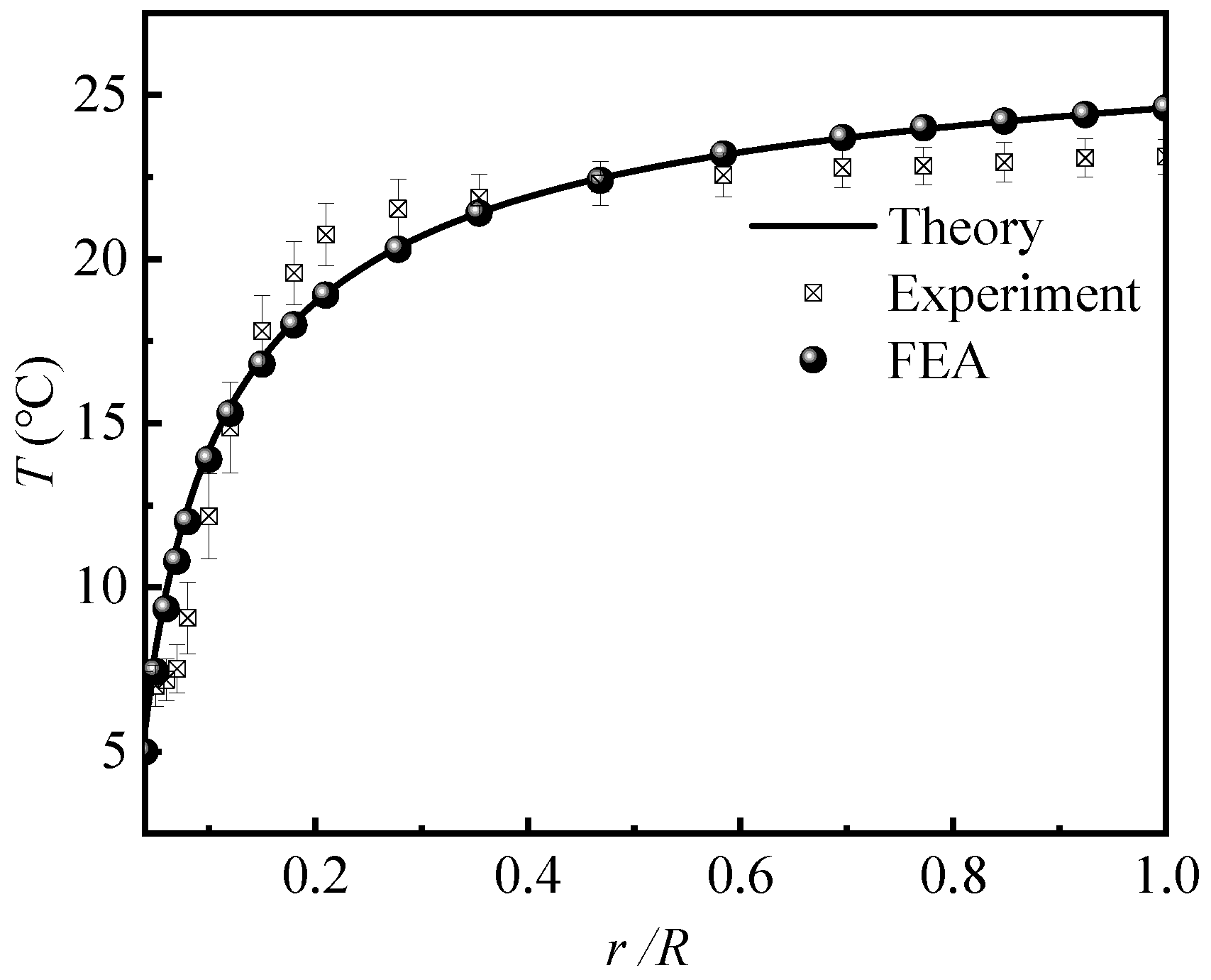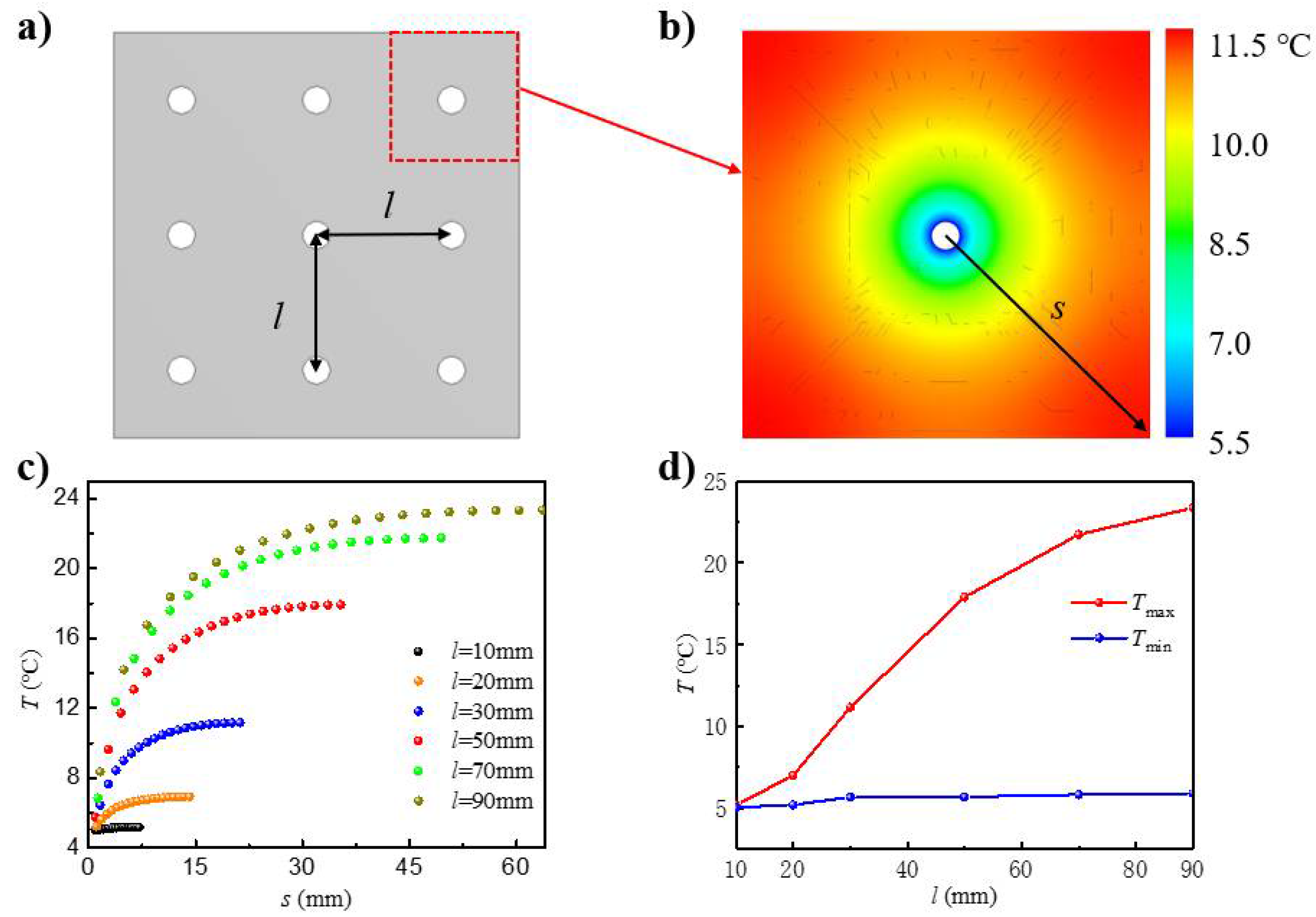Thermal Analysis on Active Heat Dissipation Design with Embedded Flow Channels for Flexible Electronic Devices
Abstract
:1. Introduction
2. Theoretical Model
3. Results and Discussion
3.1. Model Verification
3.2. Influences of Fluid Temperature and Flow Velocity
3.3. Thermal Analysis of Active Heat Dissipation Design with Multiple Flow Channels
4. Conclusions
Author Contributions
Funding
Conflicts of Interest
References
- Ausra, J.; Wu, M.Z.; Zhang, X.; Vázquez-Guardado, A.; Skelton, P.; Peralta, R.; Avila, R.; Murickan, T.; Haney, C.R.; Huang, Y.G.; et al. Wireless, battery-free, subdermally implantable platforms for transcranial and long-range optogenetics in freely moving animals. Proc. Natl. Acad. Sci. USA 2021, 118, e2025775118. [Google Scholar] [CrossRef]
- Ghaffari, R.; Rogers, J.A.; Ray, T.R. Recent progress, challenges, and opportunities for wearable biochemical sensors for sweat analysis . Sens. Actuators B Chem. 2021, 332, 129447. [Google Scholar] [CrossRef]
- Beker, L.; Matsuhisa, N.; You, I.; Ruth, S.R.A.; Niu, S.M.; Foudeh, A.; Tok, J.B.H.; Chen, X.D.; Bao, Z.A. A bioinspired stretchable membrane-based compliance sensor. Proc. Natl. Acad. Sci. USA 2020, 117, 11314–11320. [Google Scholar] [CrossRef] [PubMed]
- Wang, C.J.; Cai, M.; Hao, Z.M.; Nie, S.; Liu, C.Y.; Du, H.G.; Wang, J.; Chen, W.Q.; Song, J.Z. Stretchable, multifunctional epidermal sensor patch for surface electromyography and strain measurements. Adv. Intell. Syst. 2021, 2100031. [Google Scholar] [CrossRef]
- Yu, K.; Rich, S.; Lee, S.; Fukuda, K.; Yokota, T.; Someya, T. Organic photovoltaics: Toward self-powered wearable electronics. Proc. IEEE 2019, 107, 2137–2154. [Google Scholar] [CrossRef]
- Jinno, H.; Yokota, T.; Koizumi, M.; Yukita, W.; Saito, M.; Osaka, I.; Fukuda, K.; Someya, T. Self-powered ultraflexible photonic skin for continuous bio-signal detection via air-operation-stable polymer light-emitting diodes. Nat. Commun. 2021, 12, 2234. [Google Scholar] [CrossRef] [PubMed]
- Ma, Q.; Zhang, Y.H. Mechanics of fractal-inspired horseshoe microstructures for applications in stretchable electronics. J. Appl. Mech. 2016, 83, 111008. [Google Scholar] [CrossRef]
- Zhang, F.; Li, S.P.; Shen, Z.M.; Cheng, X.; Xue, Z.G.; Zhang, H.; Song, H.L.; Bai, K.; Yan, D.J.; Wang, H.L.; et al. Rapidly deployable and morphable 3D mesostructures with applications in multimodal biomedical devices. Proc. Natl. Acad. Sci. USA 2021, 118, e2026414118. [Google Scholar] [CrossRef] [PubMed]
- Zhang, S.; Wang, C.J.; Linghu, C.H.; Wang, S.H.; Song, J.Z. Mechanics strategies for implantation of flexible neural probes. J. Appl. Mech. 2021, 88, 010801. [Google Scholar] [CrossRef]
- Nie, S.; Cai, M.; Wang, C.J.; Song, J.Z. Fatigue life prediction of serpentine interconnects on soft elastomers for stretchable electronics. J. Appl. Mech. 2020, 87, 011011. [Google Scholar] [CrossRef]
- Wang, Y.H.; Yin, L.; Bai, Y.Z.; Liu, S.Y.; Wang, L.; Zhou, Y.; Hou, C.; Yang, Z.Y.; Wu, H.; Ma, J.J.; et al. Electrically compensated, tattoo-like electrodes for epidermal electrophysiology at scale. Sci. Adv. 2020, 6, eabd0996. [Google Scholar] [CrossRef]
- Zhu, C.; Guo, D.L.; Ye, D.; Jiang, S.; Huang, Y.A. Flexible PZT-integrated, bilateral sensors via transfer-free laser lift-off for multimodal measurements. ACS Appl. Mater. Interfaces 2020, 12, 37354–37362. [Google Scholar] [CrossRef] [PubMed]
- O’Neill, S.J.K.; Gong, H.X.; Matsuhisa, N.; Chen, S.C.; Moon, H.; Wu, H.C.; Chen, X.F.; Chen, X.D.; Bao, Z.N. A carbon flower based flexible pressure sensor made from large-area coating. Adv. Mater. Interfaces 2020, 7, 2000875. [Google Scholar] [CrossRef]
- Rogers, J.A.; Chen, X.D.; Feng, X. Flexible hybrid electronics. Adv. Mater. 2020, 32, 1905590. [Google Scholar] [CrossRef] [PubMed] [Green Version]
- Manca, J.V.; Wondrak, W.; Croes, K.; De Ceuninck, W.; D’Haeger, V.; De Schepper, L.; Tielemans, L. The Arrhenius relation for electronics in extreme temperature conditions. In Proceedings of the 3rd European Conference on High Temperature Electronics, Berlin, Germany, 4–7 July 1999; IEEE: Piscataway, NJ, USA, 1999. [Google Scholar]
- Li, Y.H.; Chen, J.; Xing, Y.F.; Song, J.Z. Thermal management of micro-scale inorganic light-emitting diodes on an orthotropic substrate for biointegrated applications. Sci. Rep. 2017, 7, 6638. [Google Scholar] [CrossRef] [PubMed] [Green Version]
- Shi, Y.L.; Wang, C.J.; Yin, Y.F.; Li, Y.H.; Xing, Y.F.; Song, J.Z. Functional soft composites as thermal protecting substrates for wearable electronics. Adv. Funct. Mater. 2019, 29, 1905470. [Google Scholar] [CrossRef]
- Jeong, S.H.; Chen, S.; Huo, J.X.; Gamstedt, E.K.; Liu, J.H.; Zhang, S.L.; Zhang, Z.B.; Hjort, K.; Wu, Z.G. Mechanically stretchable and electrically insulating thermal elastomer composite by liquid alloy droplet embedment. Sci. Rep. 2015, 5, 18257. [Google Scholar] [CrossRef]
- Bartlett, M.D.; Kazem, N.; Powell-Palm, M.J.; Huang, X.N.; Sun, W.H.; Malen, J.A.; Majidi, C. High thermal conductivity in soft elastomers with elongated liquid metal inclusions. Proc. Natl. Acad. Sci. USA 2017, 114, 2143–2148. [Google Scholar] [CrossRef] [Green Version]
- Sun, K.Y.; Dong, H.S.; Kou, Y.; Yang, H.N.; Liu, H.Q.; Li, Y.G.; Shi, Q. Flexible graphene aerogel-based phase change film for solar-thermal energy conversion and storage in personal thermal management applications. Chem. Eng. J. 2021, 419, 129637. [Google Scholar] [CrossRef]
- Zhang, H.Y.; Pinjala, D.; Teo, P.S. Thermal management of high power dissipation electronic packages: From air cooling to liquid cooling. In Proceedings of the 5th Electronics Packaging Technology Conference, Singapore, 10–12 December 2003; IEEE: Piscataway, NJ, USA, 2003; pp. 620–625. [Google Scholar]
- Lin, L.; Chen, Y.Y.; Zhang, X.X.; Wang, X.D. Optimization of geometry and flow rate distribution for double-layer microchannel heat sink. Int. J. Therm. Sci. 2014, 78, 158–168. [Google Scholar] [CrossRef]
- Husain, A.; Kim, K.Y. Optimization of a microchannel heat sink with temperature dependent fluid properties. Appl. Therm. Eng. 2015, 28, 1101–1107. [Google Scholar] [CrossRef]
- Tuckerman, D.; Pease, R. High-performance heat sinking for VLSI. IEEE Electron Device Lett. 1981, 2, 126–129. [Google Scholar] [CrossRef]
- Perret, C.; Schaeffer, C.; Boussey, J. Microchannel integrated heat sinks in silicon technology. In Proceedings of the 33rd Industry Applications Society Annual Meeting, St. Louis, MO, USA, 12–15 October 1998; IEEE: Piscataway, NJ, USA, 1998; pp. 1051–1055. [Google Scholar]
- Lee, Y.J.; Singh, P.K.; Lee, P.S. Fluid flow and heat transfer investigations on enhanced microchannel heat sink using oblique fins with parametric study. Int. J. Heat Mass Transf. 2015, 81, 325–336. [Google Scholar] [CrossRef]
- Husain, A.; Kim, K.Y. Shape Optimization of micro-channel heat sink for micro-electronic cooling. IEEE Trans. Compon. Packag. Technol. 2008, 31, 322–330. [Google Scholar] [CrossRef]
- Sieder, E.N.; Tate, G.E. Heat transfer and pressure drop of liquids in tubes. Ind. Eng. Chem. 1936, 28, 1429–1435. [Google Scholar] [CrossRef]
- Chen, H.T.; Chou, J.C. Investigation of natural-convection heat transfer coefficient on a vertical square fin of finned-tube heat exchangers. Int. J. Heat Mass Transf. 2006, 49, 3034–3044. [Google Scholar] [CrossRef]
- Sefik, B. Laminar flow heat transfer in pipes including two-dimensional wall and fluid axial conduction. Int. J. Heat Mass Transf. 1995, 38, 1619–1625. [Google Scholar]






Publisher’s Note: MDPI stays neutral with regard to jurisdictional claims in published maps and institutional affiliations. |
© 2021 by the authors. Licensee MDPI, Basel, Switzerland. This article is an open access article distributed under the terms and conditions of the Creative Commons Attribution (CC BY) license (https://creativecommons.org/licenses/by/4.0/).
Share and Cite
Yu, Y.; Yin, Y.; Li, Y.; Li, M.; Song, J. Thermal Analysis on Active Heat Dissipation Design with Embedded Flow Channels for Flexible Electronic Devices. Micromachines 2021, 12, 1165. https://doi.org/10.3390/mi12101165
Yu Y, Yin Y, Li Y, Li M, Song J. Thermal Analysis on Active Heat Dissipation Design with Embedded Flow Channels for Flexible Electronic Devices. Micromachines. 2021; 12(10):1165. https://doi.org/10.3390/mi12101165
Chicago/Turabian StyleYu, Yanan, Yafei Yin, Yuhang Li, Min Li, and Jizhou Song. 2021. "Thermal Analysis on Active Heat Dissipation Design with Embedded Flow Channels for Flexible Electronic Devices" Micromachines 12, no. 10: 1165. https://doi.org/10.3390/mi12101165






